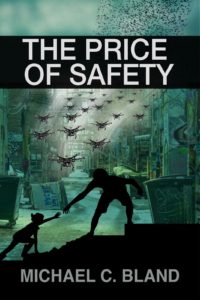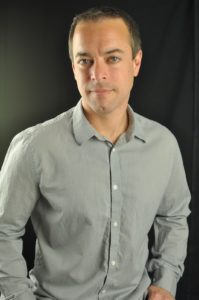FOR IMMEDIATE RELEASE:
Family takes center stage in fast-paced sci-fi thriller
DENVER, CO – In a 2013 interview with David Marchese of New York Magazine, Margaret Atwood famously stated that “within every dystopia, there’s a little utopia.” Michael C. Bland’s “The Price of Safety” (World Castle Publishing, April 6, 2020) embodies this punchy aphorism, diving into a fictional society where all citizens are safe, yet all are watched. In connection with current concerns regarding corporate and governmental data mining, Bland pulls readers along the fine line between progression and regression.
By 2047, no crime in the U.S. goes unsolved. No wrongdoing goes unseen. When Dray Quintero learns his 19-year-old daughter Raven committed a heinous act, he covers it up to save her life. This pits him against the police he’s respected since he was a child and places him in the crosshairs of Kieran, a ruthless federal Agent. To survive, Dray must overcome the surveillance system he helped build and the technology implanted in the brains and eyes of the citizens.
Forced to turn to a domestic terrorist group to protect his family, Dray soon realizes the sheer level of control of his adversaries. Hunted and betrayed, with time running out, will Dray choose his family or the near-perfect society he helped create?

“The Price of Safety”
Michael C. Bland | April 6, 2020 | World Castle Publishing | Sci-Fi Thriller
Paperback | ISBN: 9781950890804 | $13.99
 MICHAEL C. BLAND: Michael is a founding member and the secretary of BookPod: an invitation-only, online group of professional writers. He pens the monthly BookPod newsletter where he celebrates the success of their members, which include award-winning writers, filmmakers, journalists, and bestselling authors. One of Michael’s short stories, “Elizabeth,” won Honorable Mention in the Writer’s Digest 2015 Popular Fiction Awards contest. Three short stories he edited have been nominated for the Pushcart Prize. Another was adapted into an award-winning film. Michael also had three superhero-themed poems published in The Daily Palette. He currently lives in Denver with his wife Janelle and their dog Nobu. His novel, The Price of Safety, is the first in a planned trilogy. For more information about Michael’s life and work, visit www.mcbland.com.
MICHAEL C. BLAND: Michael is a founding member and the secretary of BookPod: an invitation-only, online group of professional writers. He pens the monthly BookPod newsletter where he celebrates the success of their members, which include award-winning writers, filmmakers, journalists, and bestselling authors. One of Michael’s short stories, “Elizabeth,” won Honorable Mention in the Writer’s Digest 2015 Popular Fiction Awards contest. Three short stories he edited have been nominated for the Pushcart Prize. Another was adapted into an award-winning film. Michael also had three superhero-themed poems published in The Daily Palette. He currently lives in Denver with his wife Janelle and their dog Nobu. His novel, The Price of Safety, is the first in a planned trilogy. For more information about Michael’s life and work, visit www.mcbland.com.
In an interview, Michael C. Bland can discuss:
- Why family plays a central role in “The Price of Safety” — something that is atypical for the sci-fi genre
- How he wrote this novel with readers’ shortened attention spans in mind
- What his thoughts are on utopian/dystopian fiction, and how the series connects to politics, with a message for both sides of the political spectrum
- Whether or not the book represents a plausible future for the U.S.
- His plans for the future two books in the trilogy
An Interview with Michael C. Bland
1. This book has a strong emphasis on character and family in particular. What inspired you to approach the story this way?
I love science fiction, but sometimes it seems like characters are secondary to whatever cool gadget or spaceship or world is displayed in the novel. I wanted to write a story that everyone can enjoy, so I focused on something that is relatable. In this case, the main character (Dray Quintero) is driven by his need to protect his daughters. I then used that as Dray’s primary struggle, creating a world where shielding someone is nearly impossible. The story takes place thirty years in the future when technology has become so prevalent it’s inescapable—and is being used in nefarious ways. Yet throughout the novel, I kept Dray and his family as the main focus to give it heart.
2. What are the opportunities and challenges you’ve faced when writing dystopian/utopian fiction?
Not only did I have to avoid writing a story that’s already been told, I had to make my world believable. People generally resist things that can harm them. There had to be enough of a desperate need—the decline in the country’s status in the world, increased competition we couldn’t defeat—for the technology that’s central to my story to be accepted by my fictional world (and the reader).That technology had to promise unlimited benefits, with its danger hidden from everyone until it’s too late. And as discussed earlier, I wanted to do this while keeping the focus on the characters, not only so they discover the story’s secrets along with the reader but directly suffer as a result.
3. Do you think that the future of the United States could look like it does in this book?
Absolutely. I tried to make my world as plausible as possible; otherwise, readers won’t believe the events that transpire. The implants seem too good to be true, with huge benefits, increased connectivity, an immersive viewing experience, and monitors/gauges to improve the human condition. But the technology comes with hidden risks that affect every citizen and their children.
4. How do you approach writing for a 21st-century audience with shorter attention spans?
I remained aware the entire time I wrote The Price of Safety that I was competing with readers’ phones, internet, Facebook, and every other distraction. This meant I had to quickly capture their attention and never let go. If I slowed the action at all, I risked losing them completely.
5. Can you give us a hint as to how the story might progress throughout the trilogy?
Dray’s actions at the end of The Price of Safety start a chain reaction he didn’t plan on. He has to contend with this in the second and third books, both in terms of where these events could lead and the price he’ll have to pay. He and his fellow rebels must not only continue to fight for everyone’s freedom, they’ve become known to their enemies. The battles that ensue, the revelations Dray’s group discover, and the choices they make reverberate across the country, taking them to a confrontation that’s sweeping in scope—and endangers everyone Dray cares for.

A former award-winning journalist with national exposure, Marissa now oversees the day-to-day operation of the Books Forward author branding and book marketing firm, along with our indie publishing support sister company Books Fluent.
Born and bred in Louisiana, currently living in New Orleans, she has lived and developed a strong base for our company and authors in Chicago and Nashville. Her journalism work has appeared in USA Today, National Geographic and other major publications. She is now interviewed by media on best practices for book marketing.

